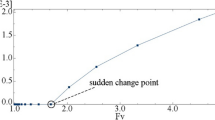Abstract
Sakurai proposed hazard warning levels (HWLs) on the basis of the critical strain concept to evaluate the stability of tunnels. When the measured strain values remain smaller than HWL III, the stability of the tunnels is confirmed. The collapses occurred in a number of tunnels existing in Iran have questioned the accuracy of the Sakurai’s criterion in spite of the smaller values of tunnel strains comparing to the HWL III. This study renders an account of the HWLs modified on the basis of the results of 162 uniaxial compression strength (UCS) tests conducted on ten types of rocks and soils. To this end, the UCS, critical strain and initial tangent modulus were first determined. Then, the upper and lower bounds of the critical strain were considered in UCS – critical strain and modified tangent modulus – critical strain graphs as the modified HWLs. According to the results, the modified HWLs are more accurate results regarding the tunnel stability conditions.
Similar content being viewed by others
References
Aydan, O., Akagi, T., and Kawamoto T. (1993). “The squeezing potential of rocks around tunnels; theory and prediction.” Rock Mech. Rock Engng., Vol. 26, No. 2, pp. 137–163, DOI: 10.1007/BF01032650.
Daraei, A. and Zare, S. (2018a). “Effect of water content variations on critical and failure strains of rock.” KSCE J. Civ. Eng., Vol. 22, No. 9, pp. 3331–3339, DOI: 10.1007/s12205-018-0592-7.
Daraei, A. and Zare, S. (2018b). “A new strain-based criterion for evaluating tunnel stability.” Geomechanics and Engineering, Vol. 16, No. 2, pp. 205–215, DOI: 10.12989/gae.2018.16.2.205.
Fujii, Y., Kiyama, T., Ishijimay, Y., and Kodama, J. (1998). “Examination of a rock failure criterion based on circumferential tensile strain.” Pure Appl. Geophys., Vol. 152, No. 3, pp. 551–577, DOI: 10.1007/s000240050167.
Gaede, O., Schrank, C., Canbulat, I., and Karrech, A. (2014). “A strain based failure criterion for pillar analysis.” Proc., AusRock 2014: Third Australian Ground Control in Mining Conference, Sydney, NSW, Australia.
Hajiabdolmajid, V. and Kaiser, P. (2003). “Brittleness of rock and stability assessment in hard rock tunneling.” Tunnelling and Underground Space Technology, Vol. 18, No. 1, pp. 35–48, DOI: 10.1016/S0886-7798(02)00100-1.
Hoek, E. (1998). “Tunnel support in weak rock.” Keynote address, Symposium of Sedimentary Rock Engineering, Taipei, Taiwan.
Kim, Y. S. and Kim, D. M. (2009). “Evaluation for applications of displacement criterion by the critical strain of uniaxial compression in rock mass Tunnel.” Journal of Korean Civil Engineering, Vol. 29, No. 6C, pp. 321–329. (in Korean).
Li, Z. (1990). “A new approach to rock failure: Criterion of failure in plastical strain space.” Engineering Fracture Mechanics, Vol. 35, Nos. 4–5, pp. 139–742, DOI: 10.1016/0013-7944(90)90156-b.
Li, J. and Villaescusa, E. (2005). “Determination of rock mass compressive strength using critical strain theory.” Proc. 40th U.S. Symposium on Rock Mechanics, Anchorage, Alaska, pp. 663.
Li, X., Wu, Z., Takahashi, M., and Yasuhara, K. (2000). “An experimental study on strain based failure criteria of brittle materials.” Journal of Applied Mechanics, Vol. 3, pp. 387–394, DOI: 10.2208/journalam.3.387.
Park, S. H., Ha, M. H., Park, G. R., and Shin, Y. S. (2008). “A study on safety assessment technique of tunnel using critical strain.” Proc. World Tunnel Congress, Agra, India, pp. 587–596.
Park, Si. and Park, Su. (2014). “Case studies for tunnel stability based on the critical strains in the ground.” KSCE Journal of Civil Engineering, Vol. 18, No. 3, pp. 765–771, DOI: 10.1007/s12205-014-0337-1.
Peng, J., Rong, G., Cai, M., and Zhou, C. (2015). “A model for characterizing crack closure effect of rocks.” Engineering Geology, Vol. 189, pp. 48–57, DOI: 10.1016/j.enggeo.2015.02.004.
Sakurai, S. (1981). “Direct strain evaluation technique in construction of underground opening.” Proc. 22nd U.S. Symposium on Rock Mechanics, Cambridge, Massachusetts, USA.
Sakurai, S. (1986). “Field measurement and hazard warning levels in NATM.” Tsuchi-To-Kiso. JSSMFE, Japan, Vol. 34.
Sakurai, S. (1997). “Lesson learned from field measurement in tunneling.” Tunnelling and Underground Space Technology, Vol. 12, No. 4, pp. 453–460, DOI: 10.1016/S0886-7798(98)00004-2.
Santi, P., Holschen, J., and Stephenson, R. (2000). “Improving elastic modulus measurements for rock based on geology.” Environmental and Engineering Geoscience, Vol. VI, No. 4, pp. 333–346, DOI: 10.2113/gseegeosci.6.4.333.
Singh, M., Singh, B., and Choudhari, J. (2007). “Critical strain and squeezing of rock mass in tunnels.” Tunnelling and Underground Space Technology, Vol. 22, No. 3, pp. 343–350, DOI: 10.1016/j.tust.2006.06.005.
Stacey, T. R. (1981). “A simple extension strain criterion for fracture of brittle rock.” Int. J. Rock Mech. Min. Sci. & Geomech. Abstr., Vol. 18, No. 6, pp. 469–474, DOI: 10.1016/0148-9062(81)90511-8.
Author information
Authors and Affiliations
Corresponding author
Rights and permissions
About this article
Cite this article
Daraei, A., Zare, S. Modifying Tunnel’s Hazard Warning Levels based on the Laboratory Studies on Different Rock Types. KSCE J Civ Eng 23, 2384–2390 (2019). https://doi.org/10.1007/s12205-019-0326-5
Received:
Revised:
Accepted:
Published:
Issue Date:
DOI: https://doi.org/10.1007/s12205-019-0326-5




